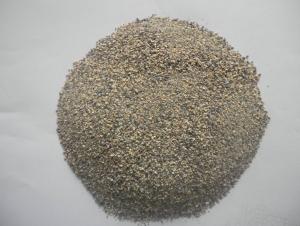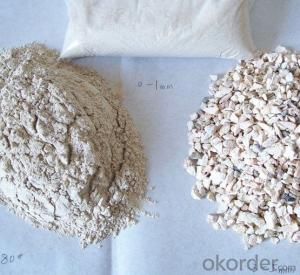Raw Materials for Refractory Fireclay Mortars
- Loading Port:
- China Main Port
- Payment Terms:
- TT OR LC
- Min Order Qty:
- -
- Supply Capability:
- -
OKorder Service Pledge
OKorder Financial Service
You Might Also Like
粘土质耐火泥浆
项目 | NN-30 | NN-38 | NN-42 | NN-45A | NN-45B | |
耐火度 ℃ 不低于 | 1630 | 1690 | 1710 | 1730 | 1730 | |
Al2O3, % 不小于 | 30 | 38 | 42 | 45 | 15 | |
冷态抗折强度,mpa不小于 C CS min | 110℃干燥后 | 1.0 | 1.0 | 1.0 | 1.0 | 2.0 |
1200℃x3h | 3.0 | 3.0 | 3.0 | 3.0 | 6.0 | |
荷重软化温度2.0% 不低于 |
|
|
|
| 1200 | |
| 1200℃x3h烧后 | 1—-3 |
| |||
1300℃x3h烧后 |
| 1—-5 | ||||
粘结时间 ,min | 1-3 | |||||
粒度 % | -1..0mm | 100 | ||||
0.5mm 不大于 | 2 | |||||
-0.074m 不小于 | 50 | |||||
Note: A is ordinary clay refractory slurry, B for phosphate combined with clay refractory mortar


- Q: Does anyone know the refractory temperature of fire-resistant glass?
- Ordinary glass will be completely liquefied in the furnace of about 1100 degrees for half an hour and will not deform below 600 degrees. toughened glass fire-resistant glass is the product of ordinary glass after being processed Glass will mainly burst after encountering fire. When unevenly heated or encountering sudden drastic changes in temperature, ordinary glass will burst if the sharp temperature difference is over 70-120 degrees and toughened glass will burst at 200 degrees. It is not yet clear of the bursting temperature for the refractory glass. (I hope this answer can help you!) Hope you adopt !)
- Q: Why the refractories should be waterproof and wetproof
- The binding agent of many raw materials is water-soluble. It will be useless when meeting water.
- Q: The effect of a high content of water in liquid resin exerted on refractory material?
- For one thing, Substandard whiteness, transportation, low quality and the storage of refractory material may account for this. For another, a high content of moisture reduced the performance of refractory material. A high content of moisture is equal to buy water with same money in terms of trade settlement. Based on this, we can’t consider the super-standard water content from a single aspect, because the water content in refractory material is definitely super-standard, and another problem is particle size. Many people hold the idea that excessive amount of water content may revive its original performance, but it tends to have influenced the quality of refractory material.
- Q: What's the fire endurance of hollow brick?
- This question is really very simple. It is better no to exceed 1050℃, or it will be easily burnt. I think 980 ℃ is ok in reality. It depends on how thick your wall is because fire endurance of hollow brick is related to wall thickness. 24 wall can generally endure for 3 hours or more.
- Q: Which kind of furnace hearth refractory is better?
- Coal is acidic medium, so the matched material should be acidic refractories oriented, like silica?bricks. For example, the coking coke oven and carbon furnace made of carbon are in reducing atmosphere, so they use silica bricks which have low price and good high-temperature indicators. If the part has special requirements, you can then consider other refractory on request.
- Q: What's the type of fire proofing thermal insulation materials?
- Aluminum silicate: AlSiO3 With flint clay clinker as raw material, aluminum silicate is made by resistance or electric-arc furnace fusion and then spraying processing. Aluminum silicate fiber, also known as ceramic fiber, is a new lightweight refractory material featured by light weight, high temperature resistance, good thermal stability, low heat conduction rate, small heat capacity, good mechanical vibration resistance, small thermal expansion and good thermal insulation. It can be processed into aluminum silicate fiber board, aluminium silicate fiber felt, aluminium silicate fiber rope, aluminium silicate fiber blanket, etc. Featured by high temperature resistance, low heat conductivity coefficient, light weight, long life, good tensile strength and elasticity and no toxin, this new sealing material is an alternative of asbestos and widely used for thermal insulation of thermal energy equipment in metallurgy, electric power, machinery, chemical industry, etc.
- Q: What are first rate fire resistant window materials?
- class A window not less than 1.2 hours, class B window not less than 0.9 hours, Class C window not less than 0.6 hours. technical requirments: 1, materials and accessories (1) the window frame is made with a certain strength sufficient to safeguard the integrity and stability of the steel frame or wooden frame. (2) steel frame and mound layer can choose the galvanized steel plate or stainless steel plate. Its selection standards is in line with GB12955 "Steel Fireproof Door General Technical Condition" provisions of Article 5.1. (3) wood frame and mound layer material selected from the standard should be consistent with GB14101 "General Technical Conditions of Wooden Fireproof Door" in the provisions of Article 5.1.1. (4 ) steel, wood frame the inside filler material should be incombustible material. (5) fireproofing glass can be used without affecting the fire windows fire resistance test approved product. light transmittance of glass should not less than 75% of commom sheet glass which is the same number of layers. ( 6) a sealing material between the frame and the fire-resistant glass flame retardant materials should be used, which can play the role of fireproofing and smoke insulation in case of fire (7) hardware fitting should be tested as approved supporting product
- Q: Which refractory is suitable for the tunnel kiln?
- Shuttle kiln refractories requires the good thermal shock properties. Because the tunnel kiln is continuous firing furnace, the temperature in the kiln is long time stable and with little fluctuation. The shuttle kiln is intermittent kiln firing. The temperature in the firing kiln is adjusted by the firing curve. It is with a relatively short time and serious fluctuation. The seal and kiln car take use of the heavy corundum brick. If it is continuous kiln, the alumina hollow ball bricks are used in the burning zone. The seal of the burning zone takes use of the kiln car brick and the seal takes use of the heavy corundum brick.
- Q: Who knows the fire endurance of rock wool color plate?
- I'm glad to answer your question and offer you some of my experiences, for reference only. rock wool board is artificial inorganic fiber taking basalt as raw material and produced by melting with high temperature, which has characteristics of lightweight, non-combustible, heat absorbing, small thermal conductivity. The initial research is a common type of application in the building mainly used for industrial buildings which should be consistent with provisions in "the application types and basic requirements of building insulation materials". Successfully tested in June, 1981 Rock wool board is a new type material with fuctions of thermal insulation, fire retardant, sound absorption. The fire endurance of general rock wool board is 140-180 degrees, within two hours, better not exceed this safe period, in order to avoid security risks.
- Q: What's the A grade fireproofing material?
- A grade fireproofing material: 1. fire-proof plate; 2. fireproof wooden door; 3. fireproof wooden window frame; 4. fire resisting shutter; 5. fireproof and mothproof wood; 6. fireproof glove compartment; 8. fire?retardant?coating; 9. fire-proof?sealing?material.
Send your message to us
Raw Materials for Refractory Fireclay Mortars
- Loading Port:
- China Main Port
- Payment Terms:
- TT OR LC
- Min Order Qty:
- -
- Supply Capability:
- -
OKorder Service Pledge
OKorder Financial Service
Similar products
Hot products
Hot Searches
Related keywords




























